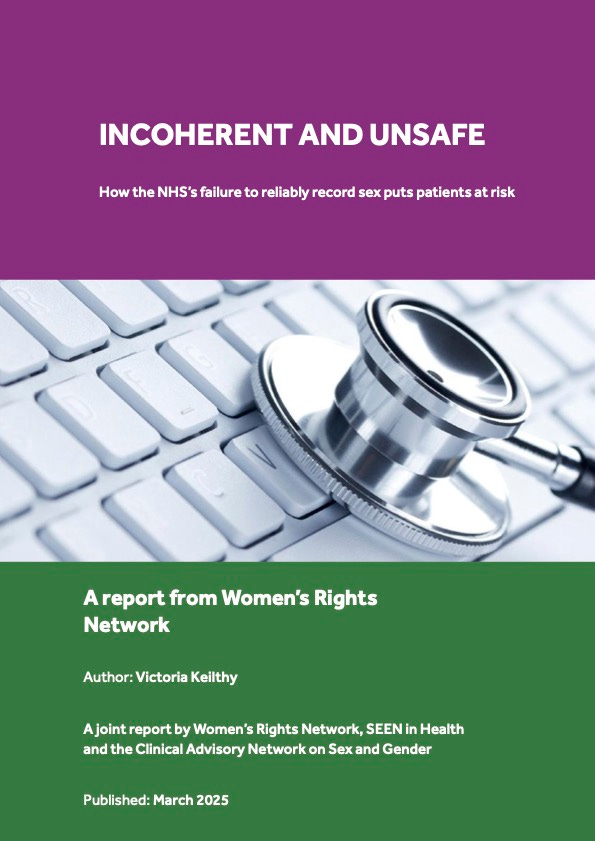How the NHS’s failure to reliably record sex puts patients at risk
A new report highlights how dangerous the NHS's gender confusion has become.
Yesterday, the government published the Sullivan Report, a long-awaited review on data and statistics on sex and gender. It is authored by Alice Sullivan, and found, to the surprise of no one, that having clear and accurate data on biological sex - not gender - is vital for understanding societal needs and providing public services. In short, public services and institutions should be dealing with reality, rather than involving themselves in fashionable political rows.
This respect and appreciation for data, science and hard facts is important in many areas, but perhaps most important when it comes to the NHS and the provision of medical care. Knowing who is a man and who is a woman is vital both for effective individual care and for wider concerns about patient safety and comfort. Stories of trans women ending up in women-only wards, or trans men missing invitations for cervical cancer screenings have made headlines, and yet the NHS still refuses to stick to biological fact when it comes to patient data.
A new report published by the Women’s Rights Network, SEEN in Health and the Clinical Advisory Network on Sex and Gender titled Incoherent and Unsafe: How the NHS’s failure to reliably record sex puts patients at risk takes a deep dive into the consequences of this confusion within the NHS. The report opens by stating ‘our sex is determined at conception and coded into every cell in our body. It shapes our anatomy, our risk of disease and it impacts our health in myriad ways.’ Even stating these basic facts can now be deemed controversial - I’m reminded of the row that erupted after biologist Robert Winston said something similar on BBC Question Time a few years ago.
But the real controversy, as Incoherent and Unsafe argues, is that the rows we might have about gender identity in the abstract are damaging people in the real world. Language is being warped in a healthcare setting, and it is putting patients at risk. The author of this excellent report - director of service transformation at an NHS trust, Victoria Keilthy - has written a guest piece for us below, detailing the harm that can result from denying reality. Read on to find out more, and you can read the entire report here.
We’ve been discussing sex, gender and the problems with trans ideology for many years at the Battle of Ideas festival - in fact, the WRN’s founding director spoke at the Battle just last year. You can watch all our debates on our YouTube channel, or listen to our Audio Archive here.
Tickets to this year’s Battle of Ideas festival — on 18 & 19 October — are now available.
INCOHERENT AND UNSAFE
How the NHS’s failure to reliably record sex puts patients at risk
Victoria Keitlthy
Sex plays a crucial role in healthcare — influencing diagnosis, treatment, prescribing, and the reference ranges used for medical tests. Given its importance to patient safety, one might assume that the NHS would maintain reliable records of patient sex.
However, a recent report by three campaign organisations - Incoherent and Unsafe: how the NHS’s failure to reliably record sex puts patients at risk - highlights the NHS in England's failure to maintain a clear and reliable record of sex in patient records, creating significant risks to patient safety. [1]
Although the NHS acknowledges the importance of sex in healthcare, it no longer requires sex to be recorded. Instead, it prioritises the recording of self-declared ‘gender’ and ‘gender identity’ in electronic patient records.
As a result, NHS patient records now contain a muddled blend of sex and gender identity data. The report identifies five different ways the NHS records sex and/or gender identity in electronic patient records. The most common approach – and the one used by GPs – is a single ‘gender’ field with no separate record of sex. NHS data guidelines define ‘gender’ as self-identified, and patients are permitted to change the ‘gender’ stated on their medical record on demand. Since ‘gender’ is self-defined, this means every patient registered with a GP has been ascribed a gender identity, even people who do not consider themselves to have one.
If gender identity is mistaken for sex in a healthcare setting, serious harm can occur. The risk is greatest for people with a trans identity – those who say they have a gender identity which does not align with their sex – since there is greater chance that their gender identity will be mistaken for their sex. Incoherent and Unsafe presents documented examples in which the incorrect recording of sex has led to significant harm to trans-identifying patients.
More than 15 years ago, an NHS working group warned about the risks of mixing sex and gender identity data in patient records. [2] Despite this, the situation has worsened. A recent worrying development is the introduction of two questions about gender identity. These questions typically ask ‘what is your gender identity?’ and ‘does your gender identity match your sex assigned at birth?’. The questions are intended to allow healthcare professionals to infer a patient’s sex without asking directly. However, the sex of some people – such as those who do not have a gender identity or who describe themselves as ‘non-binary’ – cannot be inferred from these questions. The report finds the benefits claimed for this new approach are realised only to a very limited extent. It also raises concerns about public comprehension of the questions, particularly among those for whom English is a second language.
A lack of reliable sex data undermines health research, policy development, NHS national statistics and population health management, all of which depend on accurate sex-based data. It also creates challenges for the implementation of healthcare policy. For instance, if the NHS does not have an accurate record of patients’ sex, it cannot meet its commitment to providing same-sex inpatient accommodation. The current approach may also contravene data protection law and undermine the NHS’s ability to comply with the Public Sector Equality Duty.
The NHS’s position appears to stem from a laudable desire to avoid distress to patients with a trans identity. However, recording gender identity rather than sex (or conflating these characteristics) prioritises personal identity over patient safety. This runs counter to the fundamental medical principle of ‘first, do no harm’. And, while a record of a patient’s gender identity (if they have one) can help the NHS provide personalised care, for safety reasons, sex data must be recorded.
The NHS has adopted contested ideas about gender - seemingly without critical examination - and is presenting them as fact. For example, the NHS website asserts, without evidence, that everyone has a gender identity. This risks eroding public trust in the NHS as a science-based health service.
In her review of gender-identity care for gender-questioning children and young people, Dr Hilary Cass observed that this patient cohort has been ‘exceptionalised’ compared to other young people with similarly complex presentations. [3] In a similar way, the normal rules for medical records have been set aside for trans-identifying patients: they have the opportunity to change their medical records in ways that other patients do not. However, this also exposes this patient group to a risk of serious harm and detriment which other patients are not.
The report makes seven recommendations, the first of which calls for a clear and accurate record of patient sex in all electronic patient records. It is essential that the Data (Use and Access) Bill, currently going through parliament, gives legislative backing to this by mandating the clear and accurate recording of sex in NHS patient records.
[1] Incoherent and Unsafe: How the NHS’s failure to reliably record sex puts patients at risk, published by the Women’s Rights Network, SEEN in Health and the Clinical Advisory Network on Sex and Gender on 11 March 2025.
[2] Sex and Current Gender Input and Display, NHS Connecting for Health, 25 June 2009






